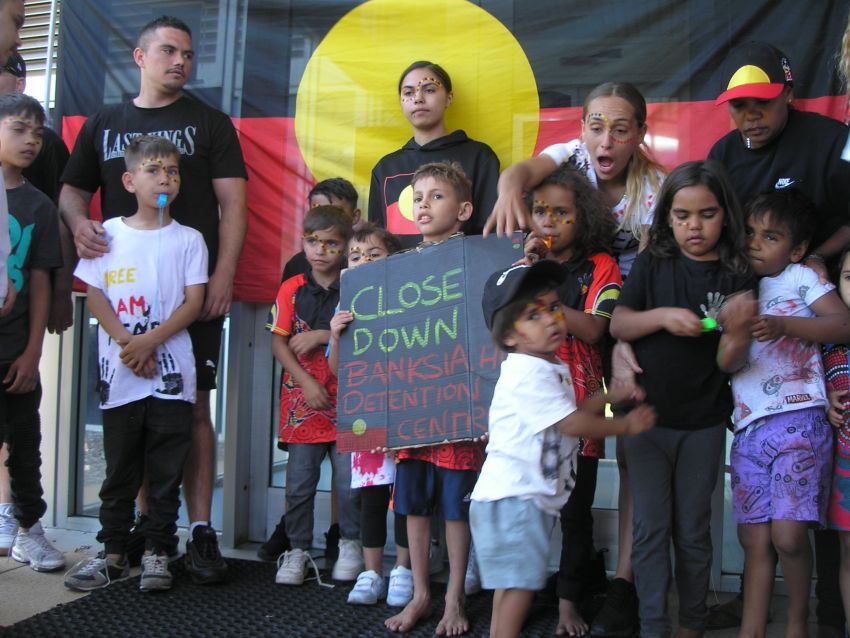
Invasion Day gets me thinking about white representations of history. Racist and mainstream narratives about Australia’s past are rightly challenged by First Nations activists. The campaign to “change the date” is building, as is truth-telling about the genocidal acts of the colonial “founding fathers”.
Just 20 metres from my workplace in the Perth CBD stands the larger-than-life bronze statue of Captain James Stirling unfurling a parchment. British naval officer and colonial administrator Stirling was instrumental in setting up the Swan River Colony.
Stirling became the first Governor and Commander-in-Chief of Western Australia in 1831. The white version of the story is that Perth owes its existence to this “enthusiastic” and “persistent” gentleman, who persuaded the British government to establish a colony here.
Less well-known is that Stirling’s family were wealthy slaveholders and that, while working his way up the ranks of the Royal Navy in the 1800s, Stirling was engaged in protecting British colonial and slave-holding interests in the Caribbean.
Also whitewashed is Stirling’s leading role in the Pinjarra Massacre of 1834 — one of the deadliest assaults on First Nations people in Western Australia’s history.
Early in the morning of October 28 of that year, Stirling, along with 25 armed men including soldiers and police, attacked a Bindjareb Noongar camp on the Murray River, 85 kilometres south of Perth.
This event has become known as the “Battle of Pinjarra” but, in truth, it was a cold-blooded massacre.
Stirling’s posse shot and killed between 15 and 80, possibly more, Bindjareb Noongar men, women and children. His letters of the time make it very clear that it was a calculated ambush: he wrote to the colonial secretary that a “check” on the Binjareb Noongar was needed after they killed a white man and aimed to “overawe the Murray tribe” and “reduce [them] to weakness” by inflicting “such acts of decisive severity as will appal them as people”.
After the massacre, Stirling threatened survivors: “If any [white] person should be killed by them, not one [Noongar] would be allowed to remain alive this side of the mountains”.
Despite his brutality, Stirling’s legacy is seen everywhere today: from the Stirling Highway that runs 18 kilometres from Perth to Fremantle; to the City of Stirling Local Government Area; the Stirling Gardens; the Stirling Ranges and more.
Last year, the City of Stirling debated a proposal submitted by local resident Jeff Bullen to change its name. Bullen argued that the use of the name “Stirling” would be like a Berlin council honouring Adolf Hitler. The proposal was debated and rejected. Noises were made about reconciliation being addressed in other ways through the city’s Reconciliation Action Plan.
Stirling was just one of a so-called party of “heroes” who attacked the Noongar camp that day in 1834. The colony’s surveyor general, John Septimus Roe, also played a leading role. Roe too is memorialised in Roe Street, Roe Highway and the town of Roebourne.
Colonist Thomas Peel also participated in the massacre. Peel now has a whole region south of Perth (Peel) named after him — an area that includes Pinjarra itself — as do hundreds of businesses and non-government organisations, such as the Peel Thunder football team, the Peel Health Campus and the LGBTIQA+ rights group Pride in Peel.
Like Stirling, the use of Peel’s name has been the subject of protest and debate. The area’s Traditional Owners, the Bindjareb people, have called for a name change.
Conservative commentators like to insist that changing colonial-era place names won’t help overcome First Nations disadvantage.
But this misses the point.
A nation that refuses to confront the truth that modern Australia was built on violent dispossession and genocide is incapable of addressing the legacies of invasion. The destruction at Juukan Gorge and the continued refusal by governments to implement the recommendations of the Royal Commission into Black Deaths in Custody is proof of that.
It’s time that white Australia stop celebrating its murderous colonisers and whitewashing history.
White Australia has a Black history, and it needs to be told. Green Left strives to this. We could do it better if you become a supporter and pledge a sum to our $200,000 Fighting Fund.
Video: Invasion Day 2022: 'We are fighting for justice'. Green Left.